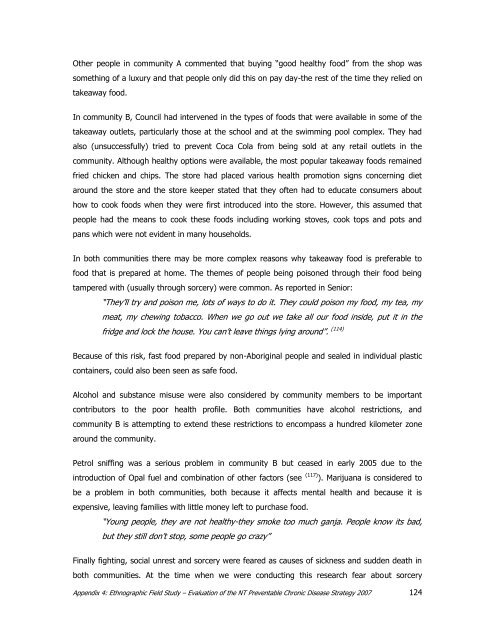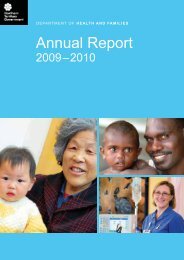PCD Strategy Evaluation 2007.pdf - NT Health Digital Library ...
PCD Strategy Evaluation 2007.pdf - NT Health Digital Library ...
PCD Strategy Evaluation 2007.pdf - NT Health Digital Library ...
You also want an ePaper? Increase the reach of your titles
YUMPU automatically turns print PDFs into web optimized ePapers that Google loves.
Other people in community A commented that buying “good healthy food” from the shop wassomething of a luxury and that people only did this on pay day-the rest of the time they relied ontakeaway food.In community B, Council had intervened in the types of foods that were available in some of thetakeaway outlets, particularly those at the school and at the swimming pool complex. They hadalso (unsuccessfully) tried to prevent Coca Cola from being sold at any retail outlets in thecommunity. Although healthy options were available, the most popular takeaway foods remainedfried chicken and chips. The store had placed various health promotion signs concerning dietaround the store and the store keeper stated that they often had to educate consumers abouthow to cook foods when they were first introduced into the store. However, this assumed thatpeople had the means to cook these foods including working stoves, cook tops and pots andpans which were not evident in many households.In both communities there may be more complex reasons why takeaway food is preferable tofood that is prepared at home. The themes of people being poisoned through their food beingtampered with (usually through sorcery) were common. As reported in Senior:“They‟ll try and poison me, lots of ways to do it. They could poison my food, my tea, mymeat, my chewing tobacco. When we go out we take all our food inside, put it in thefridge and lock the house. You can‟t leave things lying around”. (114)Because of this risk, fast food prepared by non-Aboriginal people and sealed in individual plasticcontainers, could also been seen as safe food.Alcohol and substance misuse were also considered by community members to be importantcontributors to the poor health profile. Both communities have alcohol restrictions, andcommunity B is attempting to extend these restrictions to encompass a hundred kilometer zonearound the community.Petrol sniffing was a serious problem in community B but ceased in early 2005 due to theintroduction of Opal fuel and combination of other factors (see (117) ). Marijuana is considered tobe a problem in both communities, both because it affects mental health and because it isexpensive, leaving families with little money left to purchase food.“Young people, they are not healthy-they smoke too much ganja. People know its bad,but they still don‟t stop, some people go crazy”Finally fighting, social unrest and sorcery were feared as causes of sickness and sudden death inboth communities. At the time when we were conducting this research fear about sorceryAppendix 4: Ethnographic Field Study – <strong>Evaluation</strong> of the <strong>NT</strong> Preventable Chronic Disease <strong>Strategy</strong> 2007 124
















